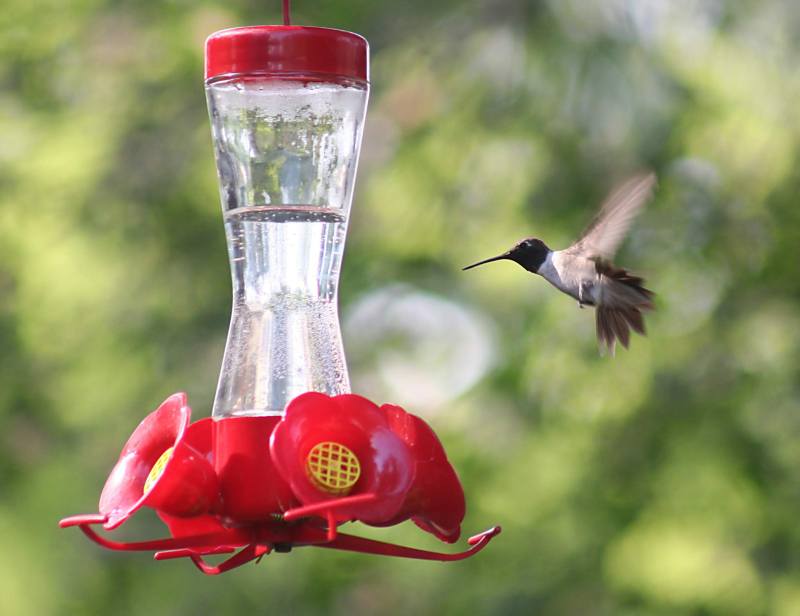All About Hummingbirds

It’s one of life’s simple joys to observe the delicate beauty of the hummingbird on a sunshiny summer day. There’s nothing like listening to the soft hum of the hummingbird’s wings as the bird zips around seeking nectar from your garden or feeder.
Hummingbirds are small, vibrant birds with iridescent feathers. They have a remarkable flying ability; like helicopters, they’re able to fly up, down, backward, right, and left.
Their wings make a distinct humming sound, which is how this high-energy bird got its name. The long-drawn slim bill of a hummingbird allows it to feed on long tubular flowers. If you live in North America, you can expect hummingbird visitors to your backyard during the summer, when flowering season is at its peak. While it’s possible to buy commercial hummingbird food at the store, preparing homemade hummingbird food is safer and more affordable.
Hummingbird Food
Recipe
Ingredients
- 1 cup organic or cane sugar
- 4 cups filtered water or natural spring water
Supplies
- hummingbird feeder
- soap and warm water
- large bowl or large measuring cup
Directions
Thoroughly wash your hummingbird feeder before filling it with hummingbird food to minimize bacterial contamination. Use soap and warm water.
Rinse the feeder thoroughly to remove all soap residue.
Mix the sugar and water in a large bowl or large measuring cup until the sugar dissolves. Pour the mixture into the feeder.
Recipe Notes
This recipe fills a 32-ounce feeder. It can also be divided into portions for several smaller feeders.
Replace homemade hummingbird food regularly, at least once every 3-4 days.
Do not rinse your feeder in bleach water. Bleach is challenging to eliminate from a feeder and can potentially harm hummingbirds.
DO NOT add red food dye, honey, molasses, artificial sweeteners, chili oil, or chili powder to your feeder.
Commercial Hummingbird Food

Commercial hummingbird food is available for purchase during the spring and summer months. You might notice that some of the food is colored red, and some is clear. What’s the difference?
Red Hummingbird Food
Red hummingbird food contains a dye that could be dangerous to your feathered friends, so it’s best to steer clear of this type of commercial feed. Although the color red does attract hummingbirds, it’s not necessary for the hummingbird food to be red. There are better and safer ways to make your feeder more welcoming.
Clear Hummingbird Food
Clear hummingbird food is just sugar and water — when you purchase it, you’re paying for the convenience of having it mixed and bottled for you. But sugar and water are cheap, and you can certainly feel better going the DIY route, since you won’t be shelling out as much cash and you’ll be able to feed twice as many hummingbirds.
How To Attract Hummingbirds To Your Feeder

If you want to see more hummingbirds in your yard, follow these tips to make your feeder more inviting:
- Place your feeder in the open so that it can be easily found by hummingbirds.
- Purchase a red feeder, like this one.
- Hang your feeder near a bed of brightly colored flowers, preferably red ones.
- Tie a red ribbon to the feeder.
- Purchase and hang two feeders to keep one bird from taking over an entire feeder.
How To Keep Other Animals Away From Your Feeder

One of your biggest challenges will be keeping pests from trying to get some of that sweet homemade hummingbird food. Luckily, there are some ways to keep them out:
- To avoid an army of ants going on a picnic, try purchasing a dripless hummingbird feeder or a feeder with an ant moat.
- To limit the number of bees buzzing around your feeder, avoid purchasing feeders with yellow decorations.
- Purchase some nectar guard tips to place over the hummingbird feeder to prevent bees and bats from feeding.
- Bring your hummingbird feeder inside at night to discourage raccoons and bats.
- If larger birds are a problem, hang larger bird feeders nearby.
Now that you have filled your feeder with the best homemade hummingbird food, you can sit back and enjoy the beauty of these lovely birds.
